HESS (High Energy Stereoscopic System)
Astronomy and Telescopes
HESS (High Energy Stereoscopic System)
The H.E.S.S. Telescopes Status References
H.E.S.S. is a system of Imaging Atmospheric Cherenkov Telescopes that investigates cosmic gamma rays in the energy range from 10s of GeV to 10s of TeV. The name H.E.S.S. stands for High Energy Stereoscopic System, and is also intended to pay homage to Victor Hess, who received the Nobel Prize in Physics in 1936 for his discovery of cosmic radiation. The instrument allows scientists to explore gamma-ray sources with intensities at a level of a few thousandths of the flux of the Crab nebula (the brightest steady source of gamma rays in the sky). H.E.S.S. is located in Namibia, near the Gamsberg mountain, an area well known for its excellent optical quality. The first of the four telescopes of Phase I of the H.E.S.S. project went into operation in Summer 2002; all four were operational in December 2003, and were officially inaugurated on September 28, 2004. A much larger fifth telescope - H.E.S.S. II - is operational since July 2012, extending the energy coverage towards lower energies and further improving sensitivity. 1)
The H.E.S.S. observatory is operated by a collaboration of more than 260 scientists from about 40 scientific institutions and 13 different countries: Namibia and South Africa, Germany, France, the UK, Ireland, Austria, the Netherlands, Poland, Sweden, Armenia, Japan, and Australia. To date, the H.E.S.S. Collaboration has published over 100 articles in high-impact scientific journals, including the top-ranked ‘Nature’ and ‘Science’ journals.
In 2006, H.E.S.S. was awarded the Descartes Prize of the European Commission - the highest recognition for collaborative research - and in 2010 the prestigious Rossi Prize of the American Astronomical Society. In a survey in 2006, H.E.S.S. was ranked the 10th most influential observatory worldwide, joining the ranks with the Hubble Space Telescope or the telescopes of the European Southern Observatory ESO in Chile.
September 2012 marked the 10th anniversary of the inauguration of the first H.E.S.S. telescope. See the highlights in H.E.S.S. history, the H.E.S.S. Hall of Fame for the most highly-cited H.E.S.S. publications, and the H.E.S.S. Sky featured in the September 2012 Source of the Month column.
Celebrated on Sept. 28, 2012 was also the inauguration of the H.E.S.S. II telescope. Following a workshop on Heja Lodge near Windhoek, the H.E.S.S. II telescope was inaugurated on Sept. 28, 2012; keynote speaker was the Hon. Minister of Education, Dr. Abraham Iyambo. Many hundred visitors came to the Open Day on Sept. 30, 2012 to see the giant new H.E.S.S. II telescope. See web galleries with pictures from the inauguration, from the open day and more telescope images are now online. See also the telescopes 'dancing' (80 MB version, 8 MB version) . Images by Christian Föhr, MPIK (Max Planck Institute for Nuclear Physics), Heidelberg.
In 2015-2016, the camera of the four H.E.S.S. I telescopes were fully refurbished using state of the art electronics and in particular the NECTAr readout chip designed for the next big experiment in the field, the Cherenkov Telescope Array (CTA). The new camera were inaugurated on Sept. 27th, 2016.
Physics Goals of H.E.S.S.
The basic goal of H.E.S.S. is to provide a comprehensive study of energetic non-thermal phenomena in the universe, using VHE (Very High Energy) gamma-ray emission as a diagnostic tool, with emphasis on the precise spectral and spatial mapping of sources. VHE gamma rays are (almost) always secondary products; one is primarily interested in the parent populations, including in particular galactic and extragalactic non-thermal electron populations, and the nucleonic component of the non-thermal universe. In addition, issues in observational cosmology and astroparticle physics can be addressed, and sky surveys will provide an unbiased view of the VHE gamma-ray sky. 2) 3)
Gamma rays from non-thermal electron populations are characterized by their double-humped spectra governed by synchrotron radiation at low (often keV) energies, and by the Inverse Compton (IC) component at high energies. From the analysis of multiwavelength spectra, the electron spectrum and the local B fields can be determined. Interesting galactic sources include pulsar nebulae; a source of the strength of the Crab Nebula can be detected by H.E.S.S. almost anywhere in the Galaxy. Among extragalactic sources, AGNs (Active Galactic Nuclei) are of special interest. HESS will be able to detect a source like Mrk 501 out to z ~0:3, limited mainly by the 1=r2 decrease in flux rather than by absorption of gamma rays in interactions with the IR/O (Infrared/Optical) background.
A central part of the HESS program will be the search for the elusive sources of the nucleonic cosmic rays (CR). Here, gamma rays are used to probe the product of the local CR density times the local gas density. Targets include SNR as CR sources, but also Giant Molecular Clouds which allow to probe the distribution and spectrum of CR throughout the Galaxy. Probing the CR flux in external galaxies is also of great interest; here, starburst galaxies and clusters of galaxies are expected to generate a detectable gamma-ray flux.
Observational cosmology and astroparticle physics with HESS includes the measurement of the IR/O background density with its implications concerning the history of galaxy formation, the search for pair halos around AGNs, which allow to measure absolute distances, and the search for WIMP (Weakly Interacting Massive Particles) annihilation lines from the Galactic center.
The Cherenkov Technique
Cherenkov radiation: The radiation is named after the Soviet scientist Pavel Cherenkov, the 1958 Nobel Prize winner, who was the first to detect it experimentally under the supervision of Sergey Vavilov at the Lebedev Institute (Moscow) in 1934. Therefore, it is also known as Vavilov–Cherenkov radiation.
The detection of high energy gamma rays with the H.E.S.S. telescopes is based on the imaging air Cherenkov technique. 4)
• An incident high-energy gamma ray interacts high up in the atmosphere and generates an air shower of secondary particles. The number of shower particles reaches a maximum at about 10 km height, and the shower dies out deeper in the atmosphere. Since the shower particles move at essentially the speed of light, they emit Cherenkov light, a faint blue light.
• The Cherenkov light is beamed around the direction of the incident primary particle and illuminates on the ground an area of about 250 m diameter, often referred to as the Cherenkov light pool. For a primary photon at TeV energy (1012 eV), only about 100 photons per m2 are seen on the ground. They arrive within a very short time interval, a few nanoseconds.
• A telescope located somewhere within the light pool will "see" the air shower, provided that its mirror area is large enough to collect enough photons. The "effective detection area" of a Cherenkov telescope is therefore given roughly by the area of the Cherenkov light pool, about 50,000 m2, to be compared with the sub-m2 detection area of satellite instruments aiming to detect gamma rays before they interact with the atmosphere.
• The image obtained with the telescope shows the track of the air shower, which points back to the celestial object where there incident gamma ray originated. The intensity of the image is related to the energy of the gamma ray. The shape of the image can be used to reject unwanted "background", such as showers induced by cosmic ray particles.
• With a single telescope providing a single view of a shower, it is difficult to reconstruct the exact geometry of the air shower in space. The achieve this, multiple telescopes are used which view the shower from different points and allow a stereoscopic reconstruction of the shower geometry.
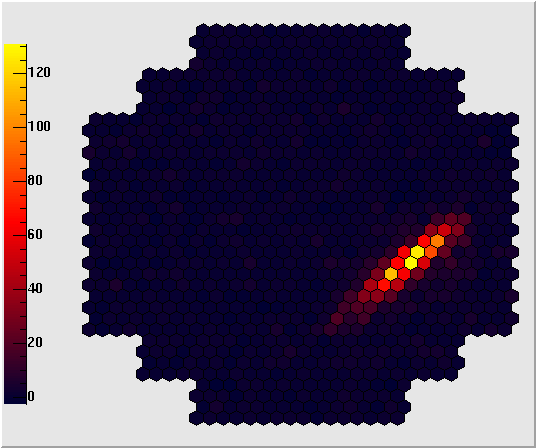
Arrangement of the Telescopes
H.E.S.S. is a stereoscopic telescope system, where multiple telescopes view the same air shower.
• The initial four H.E.S.S. telescopes (Phase I) are arranged in form of a square with 120 m side length, to provide multiple stereoscopic views of air showers. The telescope spacing represents a compromise between the large base length required for good stereoscopic viewing of the showers, and the requirement that two or more telescopes are hit by light generated by a shower. Showers emit their Cherenkov light at a height of about 10 km, and at a corresponding distance from the telescopes; hence even the 120 m spacing results in rather small angles between different views. On the other hand, given the 250 m diameter of the Cherenkov light pool, a larger spacing would make it increasingly unlikely that multiple telescopes are illuminated simultaneously.
• The diagonal of the square is oriented north-south.
• In Phase II of the project, an single huge dish with about 600 m2 mirror area was added at the center of the array, increasing the energy coverage, sensitivity and angular resolution of the instrument.
The 12 m H.E.S.S. I Telescopes
• The telescopes (here before mirror installation, side view, front view) use an alt-azimuth mount, to point the telescope at any point in the sky. A "base frame" rotates around a vertical axis and carries the dish, which rotates around the elevation axis. Both the base frame and the dish are realized as steel space frames. Technical drawings show a telescope from the front and back. Both axes are driven under computer control to track a celestial object across the sky.
• The drive system combines for each axis a servo-controlled AC motor and a backup battery-driven DC motor. In order to reduce the drive forces, the drives act on circular rails of about 7 m radius. The maximum speed of the drive systems is about 100º/min, in order to allow rapid slewing from one object to another. The servo controllers and batteries for the DC drive are located in a small hut on the base frame.
• The pointing is controlled by angular position encoders connected to both axes, which provide a resolution of a few arc-seconds (17 bit digital readout plus an additional analog track). Telescope pointing is in addition monitored by an optical guide telescope (f=800 mm) equipped with a CCD camera, which serves to correct deviations from perfect pointing.
• Weight: The complete telescope has a mass of about 60 tons, inclusive camera, drive systems, and mirrors.
Detailed information about the telescope construction, the mirrors and their optical characteristics can be found in the publications:
- Part II: mirror alignment and point spread function
H.E.S.S. Telescopes
Site: H.E.S.S. is a system of Cherenkov Telescopes located in the Khomas Highland in Namibia,on the Farm Goellschau, about 100 km south-west of Windhoek, Namibias capital.The location is: 23º16'18'' S, 16º30'00'' E at 1800 m above sea level.
H.E.S.S. is targeted at the observation of very high energy gamma rays (>100 GeV) produced in violent processes in the universe. Being in the southern hemisphere, H.E.S.S. is very well located for observations of gamma-ray sources within our galaxy, the Milky Way (see image). The H.E.S.S. group in Zeuthen is working on pulsar wind nebulae, the Magellanic Clouds, stellar bow shocks and the search for time-variable gamma-ray outbursts. 5)
The H.E.S.S. experiment has been operational with four 12-meter telescopes since 2003 and has opened a new window to the universe. Besides Milky Way sources, it has a rich and wide physics program, covering also outbursts in very distant galaxies and fundamental physics questions related to dark matter and Lorentz invariance effects as predicted by loop quantum gravity.
In 2012, a fifth telescope was inaugurated. With its diameter of 28 meters, it is the biggest of its kind worldwide. The group in Zeuthen has contributed strongly to the data acquisition and analysis tools for this new telescope. In 2015/16, the cameras of the four old 12-meter telescopes were modernized. Coordinated by DESY, the upgrade replaced the camera electronics, ventilation and pneumatic systems. It was built and deployed in collaboration with other institutes and local partners in Namibia.

• On 26 July 2012, the H.E.S.S. II telescope started operation in Namibia. Dedicated to observing the most violent and extreme phenomena of the Universe in very high energy gamma-rays, H.E.S.S. II is the largest Cherenkov telescope ever built, with its 28-meter-sized mirror. Together with the four smaller (12 meter) telescopes already in operation since 2004, the H.E.S.S. (High Energy Stereoscopic System) observatory will continue to define the forefront of ground-based gamma ray astronomy and will allow deeper understanding of known high-energy cosmic sources such as supermassive black holes, pulsars and supernovae, and the search for new classes of high-energy cosmic sources. 6)
- With a mass of almost 600 tons and its 28-meter mirror - the area of two tennis courts – the new arrival is just huge. This very large telescope named H.E.S.S. II saw its first light at 0:43 a.m. on 26 July 2012, detecting its very first images of atmospheric particle cascades generated by cosmic gamma rays and by cosmic rays, marking the next big step in exploring the Southern sky at gamma-ray energies. “The new telescope not only provides the largest mirror area among instruments of this type worldwide, but also resolves the cascade images at unprecedented detail, with four times more pixels per sky area compared to the smaller telescopes” states Pascal Vincent from the French team responsible for the photo sensor package at the focus of the mirror.
- Gamma rays are believed to be produced by natural cosmic particle accelerators such as supermassive black holes, supernovae, pulsars, binary stars, and maybe even relics of the Big Bang. The universe is filled with these natural cosmic accelerators, impelling charged particles such as electrons and ions to energies far beyond what the particle accelerators built by mankind can reach. As high-energy gamma rays are secondary products of these cosmic acceleration processes, gamma ray telescopes allow us to study these high-energy sources. Today, well over one hundred cosmic sources of very high-energy gamma rays are known. With H.E.S.S. II, processes in these objects can be investigated in superior detail, also anticipating many new sources, as well as new classes of sources. In particular, H.E.S.S. II will explore the gamma ray sky at energies in the range of tens of Giga-electronvolts – the poorly-explored transition regime between space-based instruments and current ground-based telescopes, with a huge discovery potential.
- The most extreme gamma ray emitters – Active Galactic Nuclei – shine in gamma rays with an apparent energy output which is one hundred times the luminosity of the entire Milky Way, yet the radiation seems to emerge from a volume much smaller than that of our Solar System, and turns on and off in a matter of minutes, a strong signature of supermassive black holes. For some of the objects seen with the four H.E.S.S. telescopes in the last years, no counterpart at other wavelengths is known; they may represent a new type of celestial object that H.E.S.S. II will help to characterize.
- When gamma rays interact high up in the atmosphere, they generate a cascade of secondary particles that can be imaged by the telescopes on the ground and recorded in their ultra-fast photo sensor 'cameras', thanks to the emission known as Cherenkov radiation – a faint flash of blue light. The high-tech camera of H.E.S.S. II is able to record this very faint flash with an “exposure time” of a few billionths of a second, almost a million times faster than a normal camera. The H.E.S.S. II camera – with an area of the size of a garage door and a weight of almost 3 tons – is “flying” 36 meters above the primary mirror in the focal plane – at the height of a 20-story building when pointing up. Despite its size, the new telescope will be able to slew twice as fast as the smaller telescopes to immediately respond to fast and transient phenomena such as gamma ray bursts anywhere in the sky.
- The telescope structure and its drive system were designed by engineers in Germany and South Africa, and produced in Namibia and Germany. The 875 hexagonal mirror facets which make up the huge reflector were manufactured in Armenia, and individually characterized in Germany. The mirror alignment system results from a cooperation of German and Polish institutes. The camera, with its integrated electronics, was designed and built in France. The construction of the new H.E.S.S. II telescope was driven and financed largely by German and French institutions, with significant contributions from Austria, Poland, South Africa and Sweden.
- “The successful commissioning of the new H.E.S.S. II telescope represents a big step forward for the scientists of H.E.S.S., for the astronomical community as a whole, and for Southern Africa as a prime location for this field of astronomy” - so Werner Hofmann, spokesperson of the project – “H.E.S.S. II also paves the way to the realization of CTA – the Cherenkov Telescope Array— the next generation instrument ranked top priority by astroparticle physicists and funding agencies in Europe”.
- The H.E.S.S. observatory has been operated for almost a decade by the collaboration of more than 170 scientists, from 32 scientific institutions and 12 different countries: Namibia and South Africa, Germany, France, the UK, Ireland, Austria, Poland, the Czech Republic, Sweden, Armenia, and Australia. To date, the H.E.S.S. Collaboration has published over 100 articles in high-impact scientific journals, including the top-ranked ‘Nature’ and ‘Science’ journals.
Mount | |
Mount type | Alt-Az mount |
Azimuth drive system | 12 wheels in 6 bogies on 36 m diameter rail |
Height of elevation axis | 24 m |
Elevation drive system | Toothed ring on either side of the dish |
Dish | |
Dimensions | 32.6 m by 24.3 m; equivalent to 28 m circular dish |
Shape of reflector | Parabolic |
Focal length | 36 m |
Total mirror area | 614 m2 |
|
|
Mirror facets | 875 hexagonal facets of 90 cm (flat-to-flat) size |
Facet alignment | Each facet equipped with 2 actuators with 2 µm positioning step size |
Focal plane instrumentation (Camera) | |
Photo sensors | 2048 1-1/4’ photo multipliers (PMTs) |
Packaging | 128 drawers of 16 PMTs each, drawer includes digitization, trigger, slow control, high voltage generation |
Pixel size | 42 mm (hexagonal, flat-to-flat), equivalent to 0.067º |
Sensitive area / field of view | approximately 200 cm Ø, equivalent to 3.2º on the sky |
Signal recording | 1 GHz signal sampling using the SAM ASIC |
Effective exposure time | 16 ns (nanoseconds) |
Image recording rate | 3600 images/second |
Power consumption | 8 kW |
Dimensions of camera body | 227 cm wide x 240 cm high x 184 cm deep |
Camera mass | 2.8 tons |
Camera support | Quadrupod |
Total mass of telescope | 580 tons (incl. mirrors, camera) |




Mission Status
• June 03, 2021: Scientists have gained the best view yet of the brightest explosions in the universe: A specialized observatory in Namibia has recorded the most energetic radiation and longest gamma-ray afterglow of a so-called gamma-ray burst (GRB) to date. The observations with the High Energy Stereoscopic System (H.E.S.S.) challenge the established idea of how gamma-rays are produced in these colossal stellar explosions which are the birth cries of black holes, as the international team reports in the journal Science. 7)
- “Gamma-ray bursts are bright X-ray and gamma-ray flashes observed in the sky, emitted by distant extragalactic sources,” explains DESY scientist Sylvia Zhu, one of the authors of the paper. “They are the biggest explosions in the universe and associated with the collapse of a rapidly rotating massive star to a black hole. A fraction of the liberated gravitational energy feeds the production of an ultrarelativistic blast wave. Their emission is divided into two distinct phases: an initial chaotic prompt phase lasting tens of seconds, followed by a long-lasting, smoothly fading afterglow phase.”
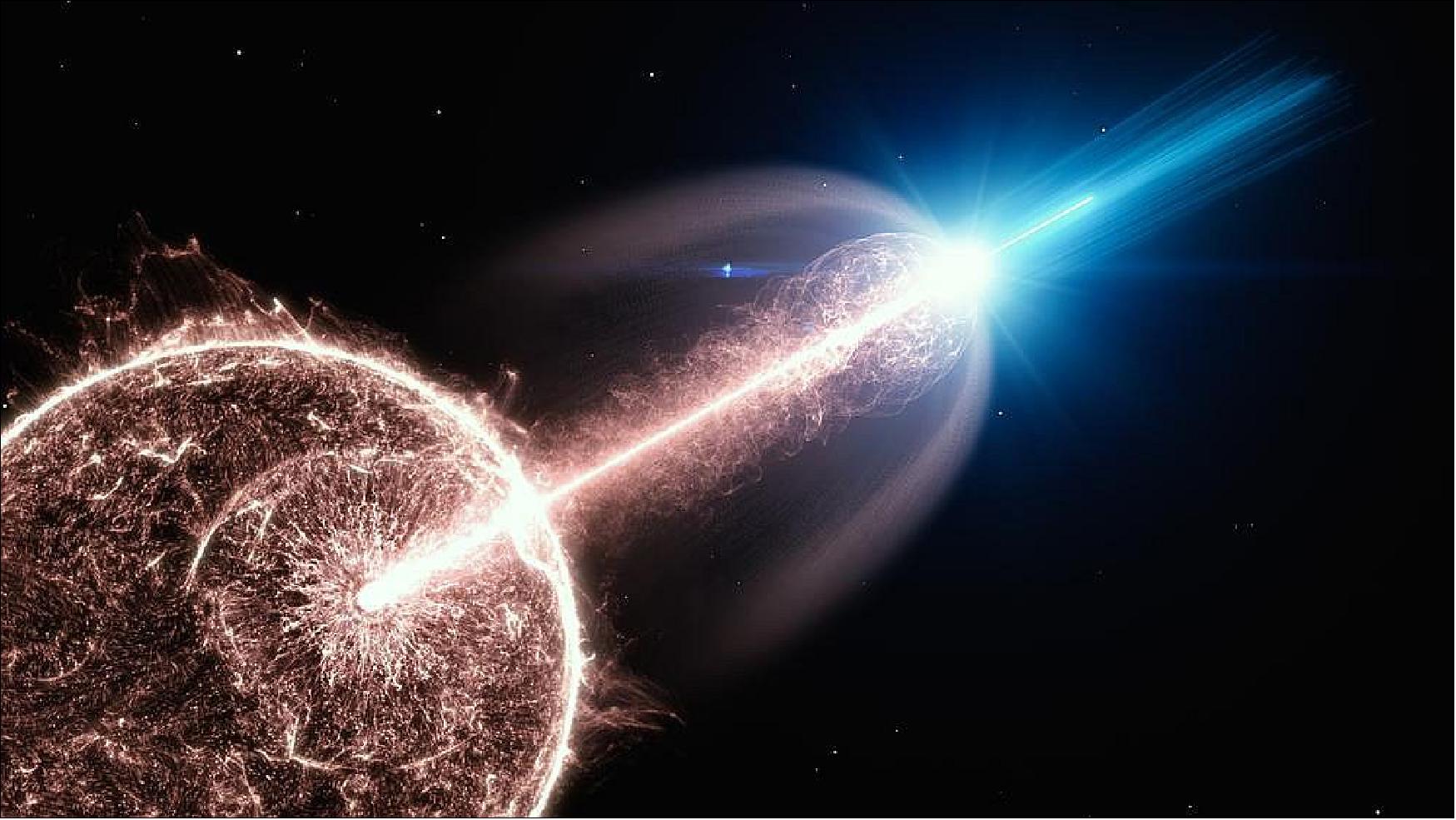
- On 29 August 2019 the satellites Fermi and Swift detected a gamma-ray burst in the constellation of Eridanus. The event, catalogued as GRB 190829A according to its date of occurrence, turned out to be one of the nearest gamma-ray bursts observed so far, with a distance of about one billion lightyears. For comparison: The typical gamma-ray burst is about 20 billion lightyears away. “We were really sitting in the front row when this gamma-ray burst happened,” explains co-author Andrew Taylor from DESY, Hamburg. The team caught the explosion's afterglow immediately when it became visible to the H.E.S.S. telescopes. “We could observe the afterglow for several days and to unprecedented gamma-ray energies,” reports Taylor.
- The comparatively short distance to this gamma-ray burst allowed detailed measurements of the afterglow's spectrum, which is the distribution of “colors” or photon energies of the radiation, in the very-high energy range. “We could determine GRB 190829A's spectrum up to an energy of 3.3 tera-electronvolts (TeV), that's about a trillion times as energetic as the photons of visible light,” explains co-author Edna Ruiz-Velasco from the Max Planck Institute for Nuclear Physics in Heidelberg. “This is what’s so exceptional about this gamma-ray burst – it happened in our cosmic backyard where the very-high-energy photons were not absorbed in collisions with background light on their way to Earth, as it happens over larger distances in the cosmos.”
- The team could follow the afterglow up to three days after the initial explosion. The result came as a surprise: “Our observations revealed curious similarities between the X-ray and very-high energy gamma-ray emission of the burst's afterglow,” reports Zhu. Established theories assume that the two emission components must be produced by separate mechanisms: the X-ray component originates from ultra-fast electrons that are deflected in the strong magnetic fields of the burst's surroundings. This “synchrotron” process is quite similar to how particle accelerators on Earth produce bright X-rays for scientific investigations.

- However, according to existing theories it seemed very unlikely that even the most powerful explosions in the universe could accelerate electrons enough to directly produce the observed very-high-energy gamma rays via this synchrotron process. This is due to a “burn-off limit”, which is determined by the balance of acceleration and cooling of particles within an accelerator. Producing very-high-energy gamma rays through synchrotron radiation requires electrons with energies well beyond the burn-off limit. Instead, current theories assume that in a gamma-ray burst, fast electrons collide with synchrotron photons and thereby boost them to gamma-ray energies in a process dubbed synchrotron self-Compton.
- But the observations of GRB 190829A's afterglow now show that both components, X-ray and gamma ray, faded in sync. Also, the gamma-ray spectrum clearly matched an extrapolation of the X-ray spectrum. Together, these results are a strong indication that X-rays and very-high-energy gamma rays in this afterglow were produced by the same mechanism. “It is rather unexpected to observe such remarkably similar spectral and temporal characteristics in the X-ray and very-high energy gamma-ray energy bands, if the emission in these two energy ranges had different origins,” says co-author Dmitry Khangulyan from Rikkyo University in Tokyo. This poses a challenge for the synchrotron self-Compton origin of the very-high energy gamma-ray emission.
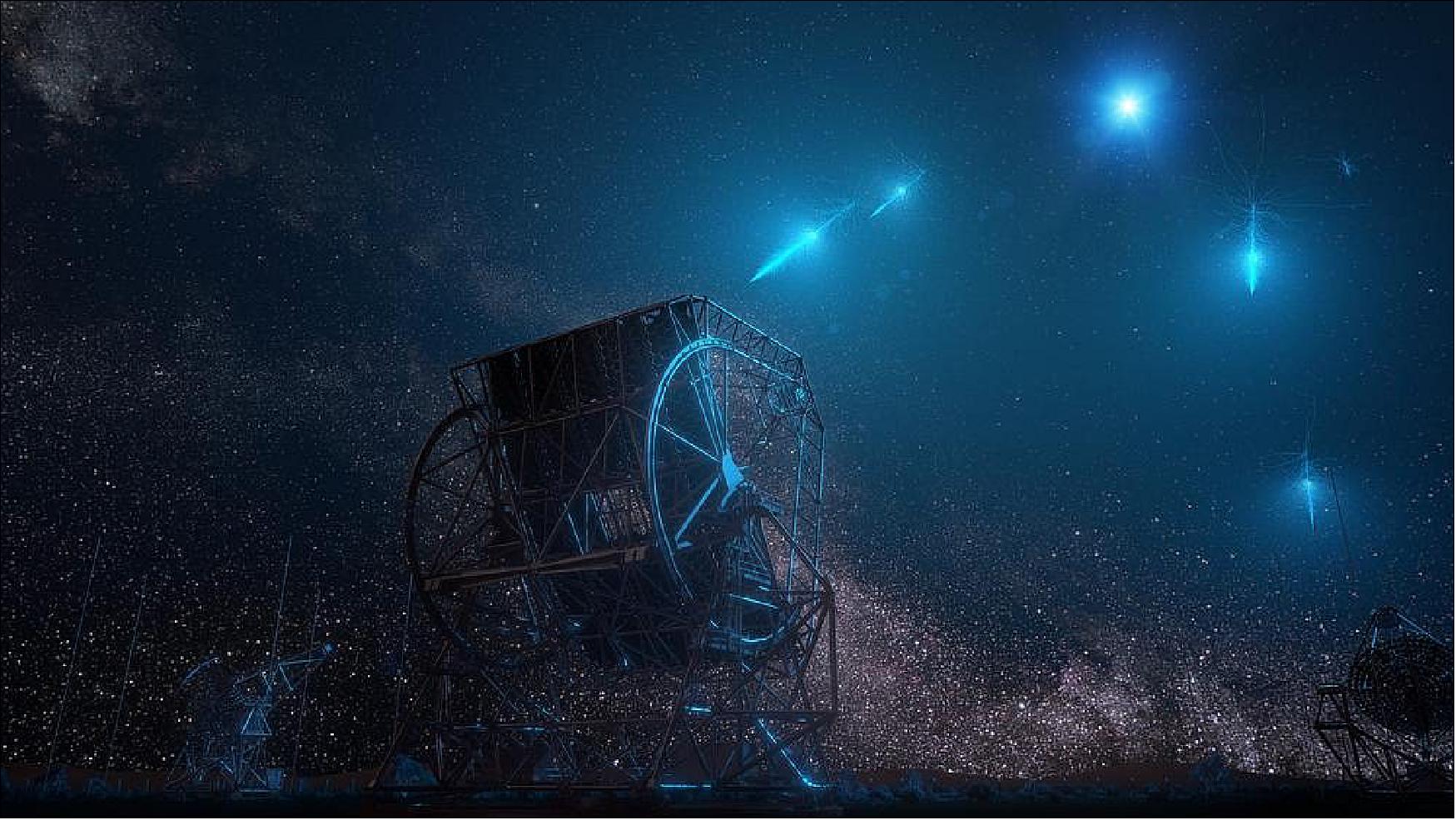
- The far-reaching implication of this possibility highlights the need for further studies of very-high energy GRB afterglow emission. GRB 190829A is only the fourth gamma-ray burst detected at very high energies from the ground. However, the earlier detected explosions occurred much farther away in the cosmos and their afterglow could only be observed for a few hours each and not to energies above 1 tera-electronvolts (TeV). “Looking to the future, the prospects for the detection of gamma-ray bursts by next-generation instruments like the Cherenkov Telescope Array that is currently being built in the Chilean Andes and on the Canary Island of La Palma look promising,” says H.E.S.S. spokesperson Stefan Wagner from Landessternwarte Heidelberg. “The general abundance of gamma-ray bursts leads us to expect that regular detections in the very-high energy band will become rather common, helping us to fully understand their physics.”
- More than 230 scientists from 41 institutes in 15 countries (Namibia, South Africa, Germany, France, the UK, Ireland, Italy, Austria, the Netherlands, Poland, Sweden, Armenia, Japan, China and Australia), comprising the international H.E.S.S. collaboration, contributed to this research. H.E.S.S. is a system of five Imaging Atmospheric Cherenkov Telescopes that investigates cosmic gamma rays. The name H.E.S.S. stands for High Energy Stereoscopic System, and is also intended to pay homage to Victor Franz Hess, who received the Nobel Prize in Physics in 1936 for his discovery of cosmic radiation. H.E.S.S. is located in Namibia, near the Gamsberg mountain, an area well known for its excellent optical quality. Four H.E.S.S. telescopes went into operation in 2002/2003, the much larger fifth telescope - H.E.S.S. II - is operational since July 2012, extending the energy coverage towards lower energies and further improving sensitivity. In 2015-2016, the cameras of the first four H.E.S.S. telescopes were fully refurbished using state of the art electronics and in particular the NECTAr readout chip designed for the next big experiment in the field, the Cherenkov Telescope Array (CTA), for which the data science management centre will be hosted by DESY on its Zeuthen site. 8)
• July 1, 2020: With a specialized telescope in Namibia a DESY-led team of researchers has proven a certain type of binary star as a new kind of source for very high-energy cosmic gamma-radiation. Eta Carinae is located 7500 lightyears away in the constellation Carina (the ship’s keel) in the Southern Sky and, based on the data collected, emits gamma rays with energies all the way up to 400 gigaelectronvolts (GeV), some 100 billion times more than the energy of visible light. The team headed by DESY’s Stefan Ohm, Eva Leser and Matthias Füßling is presenting its findings, made at the gamma-ray observatory High Energy Stereoscopic System (H.E.S.S.), in the journal Astronomy & Astrophysics. A specially created multimedia animation explains the phenomenon. “With such visualizations we want to make the fascination of research tangible,” emphasizes DESY's Director of Astroparticle Physics, Christian Stegmann. 9)
- Eta Carinae is a binary system of superlatives, consisting of two blue giants, one about 100 times, the other about 30 times the mass of our sun. The two stars orbit each other every 5.5 years in very eccentric elliptical orbits, their separation varying approximately between the distance from our Sun to Mars and from the Sun to Uranus. Both these gigantic stars fling dense, supersonic stellar winds of charged particles out into space. In the process, the larger of the two loses a mass equivalent to our entire Sun in just 5000 years or so. The smaller one produces a fast stellar wind travelling at speeds around eleven million kilometers per hour (about one percent of the speed of light).

- A huge shock front is formed in the region where these two stellar winds collide, heating up the material in the wind to extremely high temperatures. At around 50 million degrees Celsius, this matter radiates brightly in the X-ray range. The particles in the stellar wind are not hot enough to emit gamma radiation, though. “However, shock regions like this are typically sites where subatomic particles are accelerated by strong prevailing electromagnetic fields,” explains Ohm, who is the head of the H.E.S.S. group at DESY. When particles are accelerated this rapidly, they can also emit gamma radiation. In fact, the satellites “Fermi”, operated by the US space agency NASA, and AGILE, belonging to the Italian space agency ASI, already detected high-energy gamma rays of up to about 10 GeV coming from Eta Carinae in 2009.
Subatomic Hailstorm
- “Different models have been proposed to explain how this gamma radiation is produced,” Fueling reports. “It could be generated by accelerated electrons or by high-energy atomic nuclei.” Determining which of these two scenarios is correct is crucial: very energetic atomic nuclei account for the bulk of the so-called Cosmic Rays, a subatomic cosmic hailstorm striking Earth constantly from all directions. Despite intense research for more than 100 years, the sources of the Cosmic Rays are still not exhaustively known. Since the electrically charged atomic nuclei are deflected by cosmic magnetic fields as they travel through the universe, the direction from which they arrive at Earth no longer points back to their origin. Cosmic gamma rays, on the other hand, are not deflected. So, if the gamma rays emitted by a specific source can be shown to originate from high-energy atomic nuclei, one of the long-sought accelerators of cosmic particle radiation will have been identified.
- “In the case of Eta Carinae, electrons have a particularly hard time getting accelerated to high energies, because they are constantly being deflected by magnetic fields during their acceleration, which makes them lose energy again,” says Leser. “Very high-energy gamma radiation begins above the 100 GeV range, which is rather difficult to explain in Eta Carinae to stem from electron acceleration.” The satellite data already indicated that Eta Carinae also emits gamma radiation beyond 100 GeV, and H.E.S.S. has now succeeded in detecting such radiation up to energies of 400 GeV around the time of the close encounter of the two blue giants in 2014 and 2015. This makes the binary star the first known example of a source in which very high-energy gamma radiation is generated by colliding stellar winds.
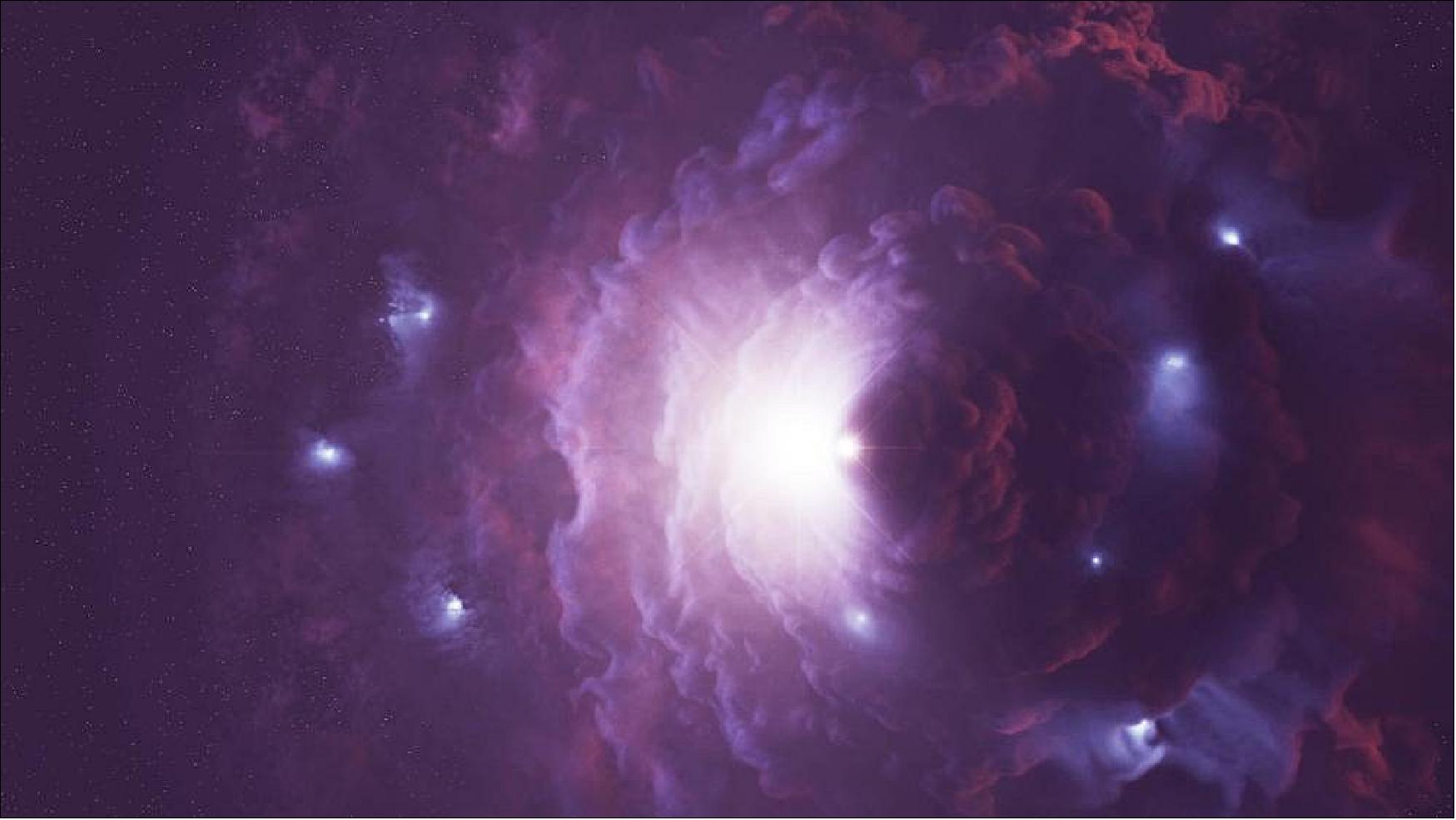
- “The analysis of the gamma radiation measurements taken by H.E.S.S. and the satellites shows that the radiation can best be interpreted as the product of rapidly accelerated atomic nuclei,” says DESY’s PhD student Ruslan Konno, who has published a companion study, together with scientists from the Max Planck Institute for Nuclear Physics in Heidelberg. “This would make the shock regions of colliding stellar winds a new type of natural particle accelerator for cosmic rays.” With H.E.S.S., which is named after the discoverer of Cosmic Rays, Victor Franz Hess, and the upcoming Cherenkov Telescope Array (CTA), the next-generation gamma-ray observatory currently being built in the Chilean highlands, the scientists hope to investigate this phenomenon in greater detail and discover more sources of this kind.
Cosmic Roadtrip
- Thanks to detailed observations of Eta Carinae at all wavelengths, the properties of the stars, their orbits and stellar winds have been determined relatively accurately. This has given astrophysicists a better picture of the binary star system and its history. To illustrate the new observations of Eta Carinae, the DESY astrophysicists have produced a video animation together with the animation specialists of the award-winning Science Communication Lab. The computer-generated images are close to reality because the measured orbital, stellar and wind parameters were used for this purpose. The internationally acclaimed multimedia artist Carsten Nicolai, who uses the pseudonym Alva Noto for his musical works, created the sound for the animation.
- “I find science and scientific research extremely important,” says Nicolai, who sees close parallels in the creative work of artists and scientists. For him, the appeal of this work also lay in the artistic mediation of scientific research results: “particularly the fact that it is not a film soundtrack, but has a genuine reference to reality,” emphasizes the musician and artist. Together with the exclusively composed sound, this unique collaboration of scientists, animation artists and musician has resulted in a multimedia work that takes viewers on an extraordinary journey to a superlative double star some 7500 light years away.
• June 18,2020: Today the H.E.S.S. collaboration published a breakthrough result in the magazine Nature, revealing the gamma-ray emission from the famous radio galaxy Centaurus A (also known as NGC 5128) to be spatially extended over thousands of light-years. This is the first time that an extragalactic source has been spatially resolved in the regime of very high energy gamma-ray astronomy and permits a direct determination of the size the region responsible for gamma-ray emission at TeV (1012 V) energies in an active galaxy. The publication, based on advanced data analysis of a large amount of excellent data obtained with the H.E.S.S. array is a technical achievement and an important step in our understanding of relativistic jets in the Universe. 10) 11)
- During the last decades the universe beyond our Milky Way has been probed in the light of very high energy (VHE) gamma-rays, identifying many different kinds of distant Quasars and other active galaxies. Curiously, those distant and extremely luminous sources of gamma-ray emission are very often found to vary within weeks or days - sometimes even as fast as hours. It was hence concluded, that the highly energetic emission originates from very compact regions - very likely linked to a massive Black Hole in the center of the host galaxy. The new study of Centaurus A observations reveals that the emitting regions of these very energetic sources are actually extended over many thousands of light-years.
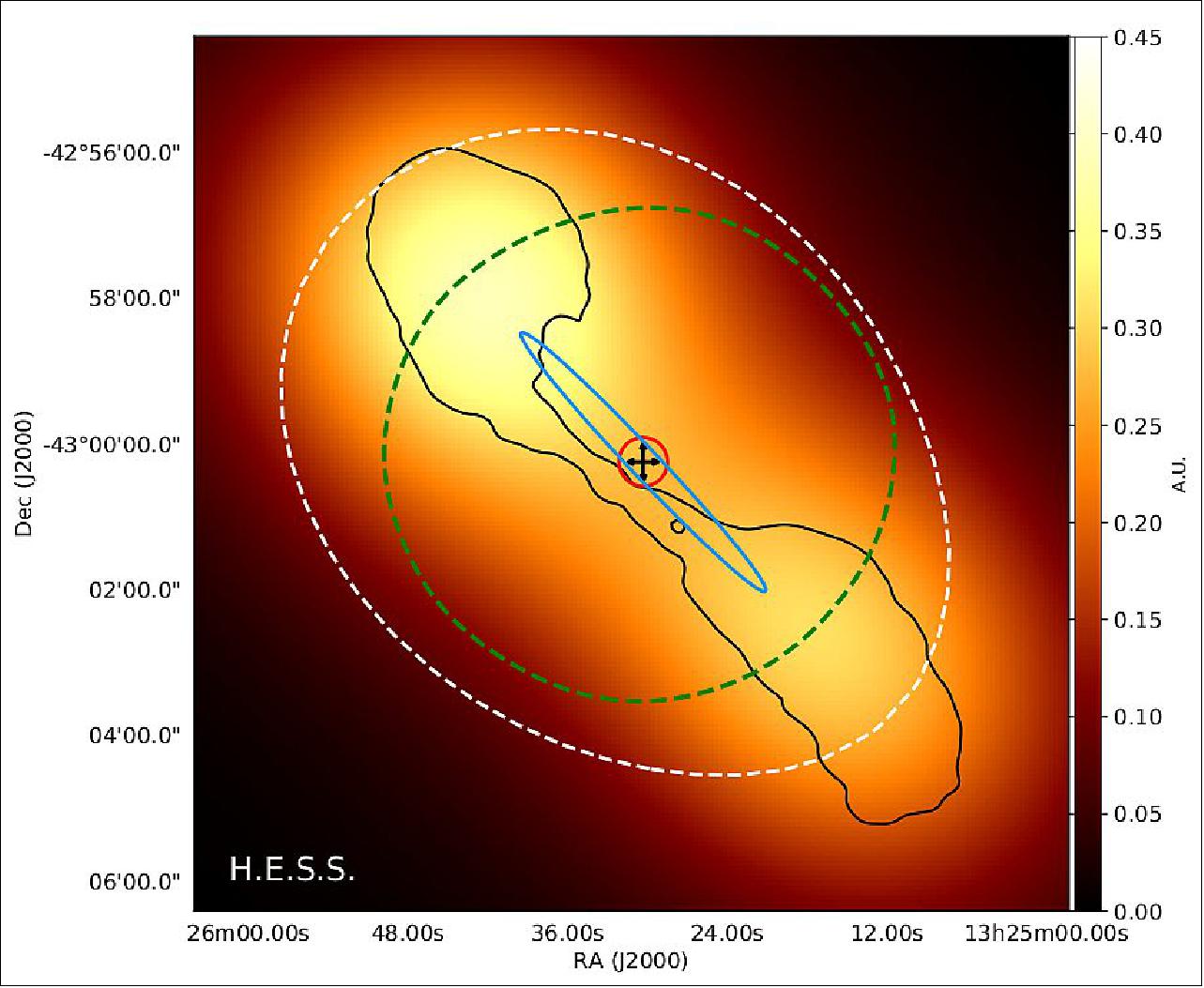
• May 10, 2020: While the COVID-19 pandemic has spread around the globe and still imposes severe restrictions in very many countries, the H.E.S.S. array was able to continue operations throughout March and April 2020 and anticipates continuous operations in the forthcoming months. This is very important for scientific investigations within the HESS collaboration and the scientific community at large and is made possible by several favorable circumstances. 12)
- The small local crew in Namibia and the observers live and work in a very isolated environment already in normal times. Thanks to early and efficient monitoring, Namibia has been able to limit the influx and spread of Corona in the country and suffers very small numbers of infections. The H.E.S.S. site is a very safe place to work and operate. At the same time, Namibian regulations during the pandemic permit the continuation of Scientific Services and thus enabled operations.
- The observers that had started their scheduled shift prior to the onset of restrictions have fortunately been able and eager to continue measurements beyond their regular slot, supported by the on-site local H.E.S.S. crew. Advancing further through these difficult times, the H.E.S.S. observing program continues thanks to members of the Namibian H.E.S.S. partner UNAM (University of Namibia), again supported by the local Namibian H.E.S.S. crew. The situation is continuously monitored as the health and safety of everybody involved is of utmost importance.
• November 20, 2019: The strongest explosions in the universe produce even more energetic radiation than previously known: Using specialized telescopes, two international teams have registered the highest energy gamma rays ever measured from so-called gamma-ray bursts, reaching about 100 billion times as much energy as visible light. The scientists of the H.E.S.S. and MAGIC telescopes present their observations in independent publications in the journal Nature. These are the first detections of gamma-ray bursts with ground-based gamma-ray telescopes. DESY plays a major role in both observatories, which are operated under the leadership of the Max Planck Society. 13) 14)
- Gamma-ray bursts (GRB) are sudden, short bursts of gamma radiation happening about once a day somewhere in the visible universe. According to current knowledge, they originate from colliding neutron stars or from supernova explosions of giant suns collapsing into a black hole. “Gamma-ray bursts are the most powerful explosions known in the universe and typically release more energy in just a few seconds than our Sun during its entire lifetime – they can shine through almost the entire visible universe,” explains David Berge, head of gamma-ray astronomy at DESY. The cosmic phenomenon was discovered by chance at the end of the 1960s by satellites used to monitor compliance with the nuclear test ban on Earth.
- Since then, astronomers have been studying gamma-ray bursts with satellites, as Earth's atmosphere very effectively absorbs gamma rays. Astronomers have developed specialized telescopes that can observe a faint blue glow called Cherenkov light that cosmic gamma rays induce in the atmosphere, but these instruments are only sensitive to gamma rays with very high energies. Unfortunately, the brightness of gamma-ray bursts falls steeply with increasing energy. Cherenkov telescopes have identified many sources of cosmic gamma rays at very high energies, but no gamma-ray bursts. Satellites, on the other hand, have much too small detectors to be sensitive to the low brightness of gamma-ray bursts at very high energies. So, it was effectively unknown, if the monster explosions emit gamma rays also in the very-high-energy regime.
- Scientists have tried for many years, to catch a gamma-ray burst with Cherenkov telescopes. Then suddenly, between summer 2018 and January 2019, two international teams of astronomers, both involving DESY scientists, detected gamma rays from two GRB events for the first time from the ground. On 20 July 2018, faint afterglow emission of GRB 180720B in the gamma-ray regime was observed with the 28-meter telescope of the High-Energy Stereoscopic System H.E.S.S. in Namibia. On 14 January 2019, bright early emission from GRB 190114C was detected by the Major Atmospheric Gamma Imaging Cherenkov (MAGIC) telescopes on La Palma, and immediately announced to the astronomical community.
- Both observations were triggered by gamma-ray satellites of the US space agency NASA that monitor the sky for gamma-ray bursts and send automatic alerts to other gamma-ray observatories upon detection. “We were able to point to the region of origin so quickly that we could start observing only 57 seconds after the initial detection of the explosion,” reports Cosimo Nigro from the MAGIC group at DESY, who was in charge of the observation shift at that time. “In the first 20 minutes of observation, we detected about thousand photons from GRB 190114C.”
- MAGIC registered gamma-rays with energies between 200 and 1000 billion electron volts (0.2 to 1 TeV). “These are by far the highest energy photons ever discovered from a gamma-ray burst,” says Elisa Bernardini, leader of the MAGIC group at DESY. For comparison: visible light is in the range of about 1 to 3 electron volts.
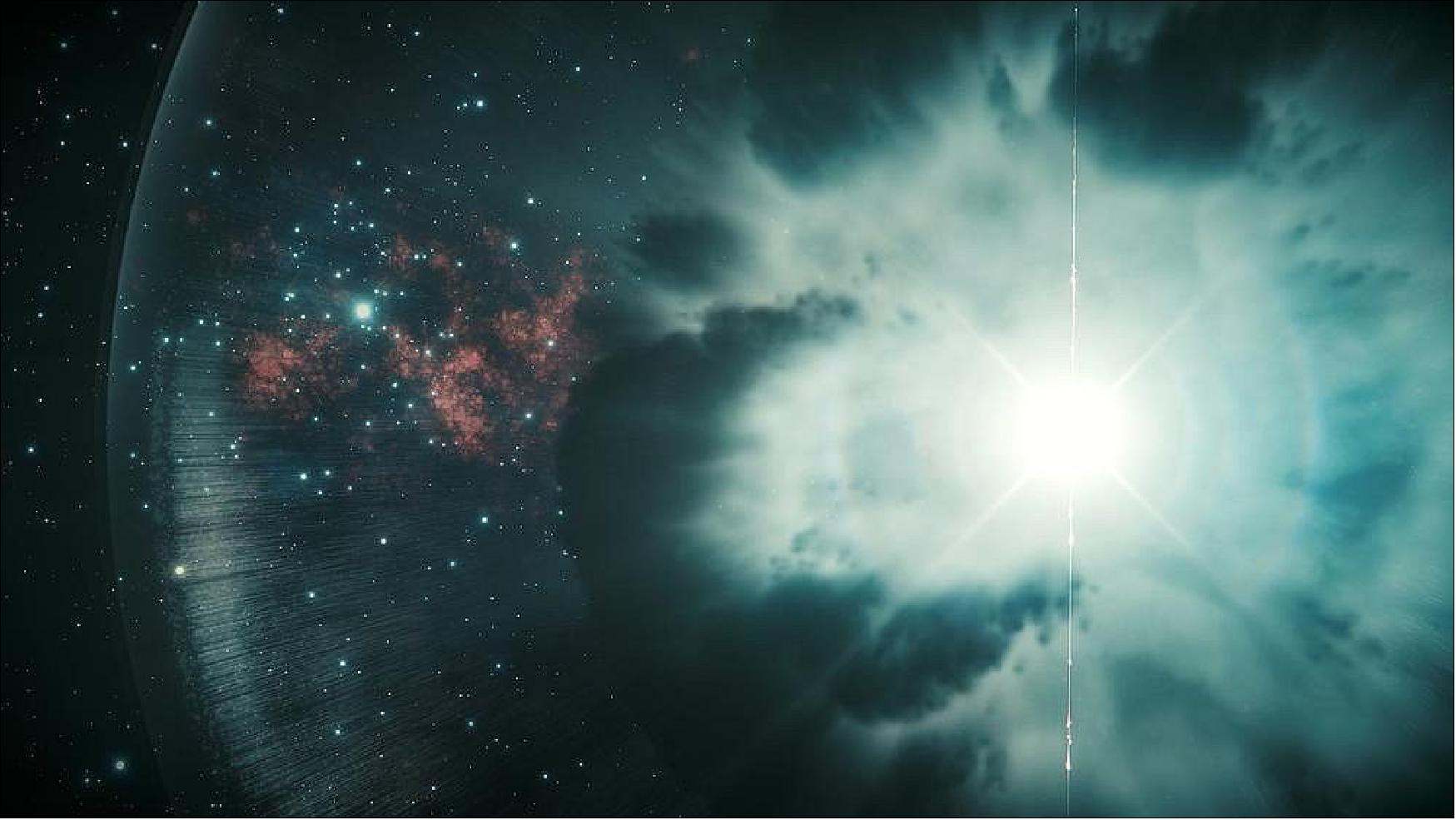
- The rapid discovery allowed to quickly alert the entire observational community. As a result, more than twenty different telescopes had a deeper look at the target. This allowed to pinpoint the details of the physical mechanism responsible for the highest-energy emission, as described in the second paper led by the MAGIC collaboration. Follow-up observations placed GRB 190114C at a distance of more than four billion light years. This means, its light travelled more than four billion years to us, or about a third of the current age of the universe.
- GRB 180720B, at a distance of six billion light years even further away, could still be detected in gamma rays at energies between 100 and 440 billion electron volts long after the initial blast. “Surprisingly, the H.E.S.S. telescope observed a surplus of 119 gamma quanta from the direction of the burst more than ten hours after the explosion event was first seen by satellites,” says Stefan Ohm, head of the H.E.S.S. group at DESY.
- “The detection came quite unexpected, as gamma-ray bursts are fading fast, leaving behind an afterglow which can be seen for hours to days across many wavelengths from radio to X-rays, but had never been detected in very-high-energy gamma rays before,” adds DESY theorist Andrew Taylor, who contributed to the H.E.S.S. analysis. “This success is also due to an improved follow-up strategy in which we also concentrate on observations at later times after the actual star collapse.”
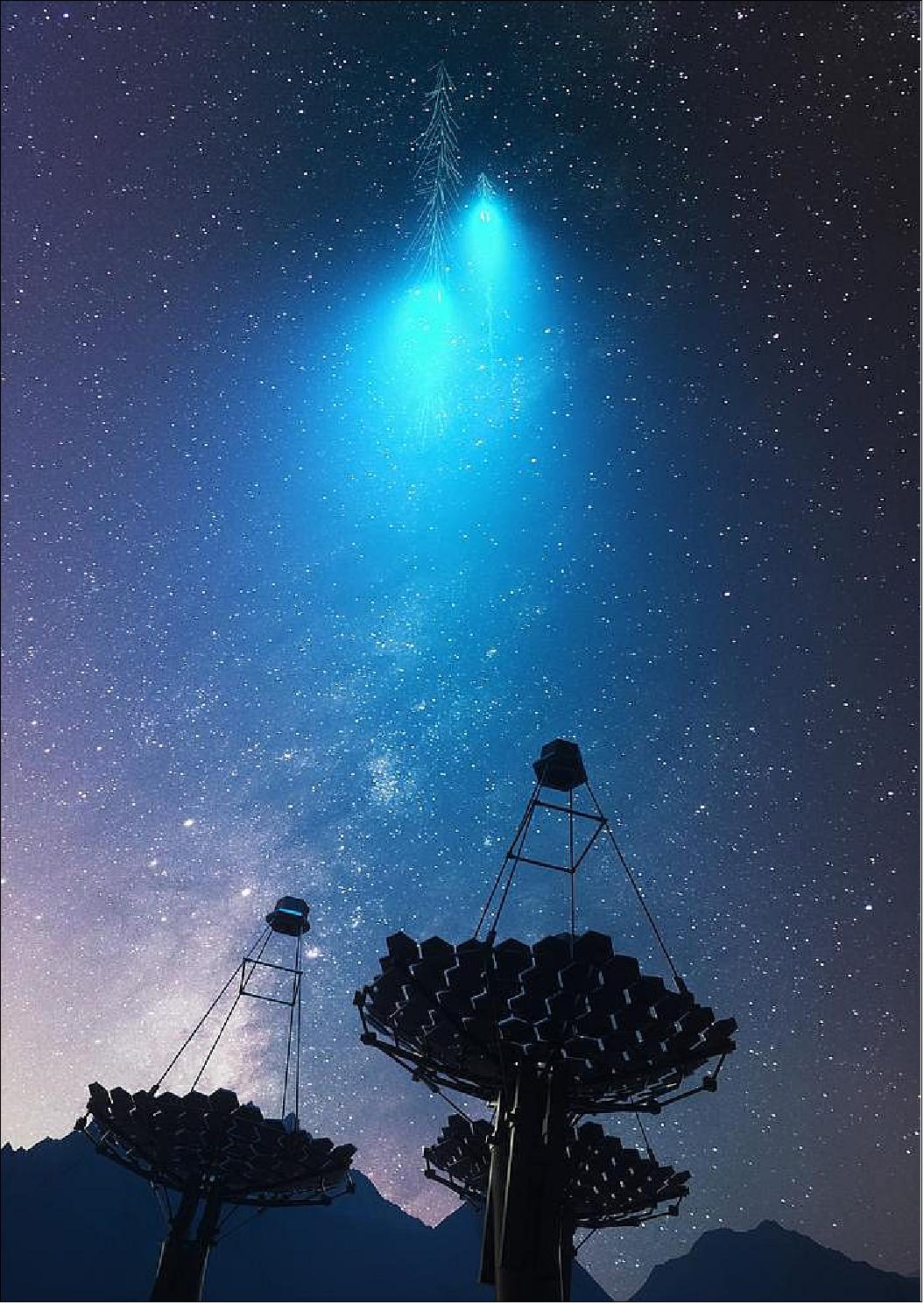
- The detection of gamma-ray bursts at very high energies provides important new insights into the gigantic explosions. “Having established that GRBs produce photons of energies hundreds of billion times higher than visible light, we now know that GRBs are able to efficiently accelerate particles within the explosion ejecta,” says DESY researcher Konstancja Satalecka, one of the scientists coordinating GRB searches in the MAGIC collaboration. “What's more, it turns out we were missing approximately half of their energy budget until now. Our measurements show that the energy released in very-high-energy gamma-rays is comparable to the amount radiated at all lower energies taken together. That is remarkable!”
- To explain how the observed very-high-energy gamma rays are generated is challenging. Both groups assume a two-stage process: First, fast electrically charged particles from the explosion cloud are deflected in the strong magnetic fields and emit so-called synchrotron radiation, which is of the same nature as the radiation that can be produced in synchrotrons or other particle accelerators on Earth, for example at DESY. However, only under fairly extreme conditions would the synchrotron photons from the explosion be able to reach the very high energies observed. Instead, the scientists consider a second step, where the synchrotron photons collide with the fast particles that generated them, which boosts them to the very high gamma-ray energies recorded. The scientists call the latter step inverse Compton scattering.
- “For the first time, the two instruments have measured gamma radiation from gamma-ray bursts from the ground,” concludes Berge. “These two groundbreaking observations have established gamma-ray bursts as sources for terrestrial gamma-ray telescopes. This has the potential to significantly advance our understanding of these violent phenomena.” The scientists estimate that up to ten such events per year can be observed with the planned Cherenkov Telescope Array (CTA) of ESO, the next generation gamma-ray observatory. The CTA will consist of more than 100 individual telescopes of three types that will be built at two locations in the northern and southern hemispheres. DESY is responsible for the construction of the medium-sized telescopes and will host CTA's Science Data Management Center on its campus in Zeuthen. CTA observations are expected to start in 2023 at the earliest.
• September 18, 2018: In September 2018, the H.E.S.S. Collaboration has, for the first time, released a small subset of its archival data in Flexible Image Transport System (FITS) format, an open file format widely used in astronomy. The release consists of event lists and instrument response functions for observations of various well-known gamma-ray sources (the Crab nebula, PKS 2155-304, MSH 15-52, RX J1713.7-3946) as well as observations of empty fields for background modeling. It is compliant to the open format specifications developed in view of the upcoming CTA Observatory. The release is meant to support the development of open-source science tools for high-level analysis of gamma-ray data by providing access to "real" gamma-ray data in the appropriate format for the first time. 15) 16)
References
1) ” H.E.S.S. High Energy Stereoscopic System,” About H.E.S.S. 2004-2019, MPG (Max Planck Gesellschaft), URL: https://www.mpi-hd.mpg.de/hfm/HESS/pages/about/
2) W. Hofmann for the H.E.S.S. Collaboration, ”Status of the High Energy Stereoscopic System (H.E.S.S.) Project,” 27th ICRC (International Cosmic Ray Conference) Hamburg, Germany, 7-15 August 2001, URL: https://www.mpi-hd.mpg.de/hfm/HESS/pages/publications/proceedings/icrc2001/ici6509_p.pdf
3) ”H.E.S.S. Physics Working Group on Multiwavelength Observations,” 30 April 2018, Uni Heidelberg, URL: https://www.lsw.uni-heidelberg.de/projects/hess/HESS/hessmultnu.php
4) ”The Cherenkov technique,” URL: https://www.mpi-hd.mpg.de/hfm/HESS/pages/about/telescopes/
5) ”The H.E.S.S. telescopes,” DESY (Deutsches Elektronen Synchroton), a Research Center of the Helmholtz Association, at Zeuthen and Hamburg; URL: https://astro.desy.de/gamma_astronomy/hess/index_eng.html
6) ”Largest ever Cherenkov telescope sees first light,” MPI-HD, 27 July 2012, URL: https://www.mpi-hd.mpg.de/hfm/HESS/pages/press/2012/HESS_II_first_light/#images
7) ”Front-row view reveals exceptional cosmic explosion,” DESY Press Release, 03 June 2021, URL: https://www.desy.de/news/news_search/index_eng.html?openDirectAnchor=2080
8) H.E.S.S. Collaboration: H. Abdalla, F. Aharonian, F. Ait Benkhali, E. O. Angüner, C. Arcaro, C. Armand, T. Armstrong, H. Ashkar, M. Backes, V. Baghmanyan, V. Barbosa Martins, A. Barnacka, M. Barnard, Y. Becherini, D. Berge, K. Bernlöhr, B. Bi, E. Bissaldi, M. Böttcher, C. Boisson, J. Bolmont, M. de Bony de Lavergne, M. Breuhaus, F. Brun, P. Brun, M. Bryan, M. Büchele, T. Bulik, T. Bylund, S. Caroff, A. Carosi, S. Casanova, T. Chand, S. Chandra, A. Chen, G. Cotter, M. Curyło, J. Damascene Mbarubucyeye, I. D. Davids, J. Davies, C. Deil, J. Devin, L. Dirson, A. Djannati-Ataï, A. Dmytriiev, A. Donath, V. Doroshenko, L. Dreyer, C. Duffy, J. Dyks, K. Egberts, F. Eichhorn, S. Einecke, G. Emery, J.-P. Ernenwein, K. Feijen, S. Fegan, A. Fiasson, G. Fichet de Clairfontaine, G. Fontaine, S. Funk, M. Füßling, S. Gabici, Y. A. Gallant, G. Giavitto, L. Giunti, D. Glawion, J. F. Glicenstein, M.-H. Grondin, J. Hahn, M. Haupt, G. Hermann, J. A. Hinton, W. Hofmann, C. Hoischen, .... . S. J. Zhu, J. Zorn, S. Zouari, N. Żywucka, P. Evans, K. Page, ”Revealing x-ray and gamma ray temporal and spectral similarities in the GRB 190829A afterglow,” Science, Vol 372, Issue 6546, 04 June 2021, pp: 1081-1085, https://doi.org/10.1126/science.abe8560
9) ”Binary star as a cosmic particle accelerator — Specialized telescope provides evidence of very high-energy gamma radiation from Eta Carinae,” DESY Press Release, 1 July 2020, URL: https://www.desy.de/news/news_search/index_eng.html?openDirectAnchor=1866
10) ”H.E.S.S. data resolve extragalactic jet in Centaurus A,” H.E.S.S. News, MPI-HD (Max Planck Institute-Heildelberg) 18 June 2020, URL: https://www.mpi-hd.mpg.de/hfm/HESS/
11) ”Resolving acceleration to very high energies along the jet of Centaurus A,” Nature, Volume 582, pp: 356-359 (2020), Published: 24 June 2020, https://doi.org/10.1038/s41586-020-2354-1
12) ”H.E.S.S. array continues observations during COVID-19 pandemic,” MPI-HD, 10 May 2020, URL: https://www.mpi-hd.mpg.de/hfm/HESS/
13) ”Gamma-Ray Bursts with record energy — First detection of the cosmic monster explosions with ground-based gamma-ray telescopes,” DESY, 20 November 2019, URL: https://www.desy.de/news/news_search/index_eng.html?openDirectAnchor=1735
14) H.E.S.S. Collaboration, H. Abdalla, R. Adam, [.....] O. J. Roberts, ”A very-high-energy component deep in the γ-ray burst afterglow,” Nature, Volume 575, pp: pages464–467(2019), Published: 20 November 2019, https://doi.org/10.1038/s41586-019-1743-9
15) ”H.E.S.S. first public test data release,” MPI-HD, 18 September 2018, URL: https://www.mpi-hd.mpg.de
/hfm/HESS/pages/dl3-dr1/
16) H.E.S.S. Collaboration , H. Abdalla, A. Abramowski, F. Aharonian, [.....] A. Ziegler, J. Zorn, and N. Zywucka, ”H.E.S.S. FITS data Data level 3, public test release,” 1September 2018, URL: https://arxiv.org/pdf/1810.04516.pdf
The information compiled and edited in this article was provided by Herbert J. Kramer from his documentation of: ”Observation of the Earth and Its Environment: Survey of Missions and Sensors” (Springer Verlag) as well as many other sources after the publication of the 4th edition in 2002. - Comments and corrections to this article are always welcome for further updates (eoportal@symbios.space).